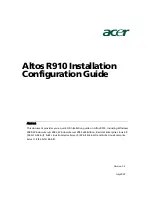
Table 20. System Security details
Option
Description
CPU AES-NI
Improves the speed of applications by performing encryption and decryption by using
the Advanced Encryption Standard Instruction Set (AES-NI). This option is set to
Enabled
by default.
System Password
Sets the system password. This option is set to
Enabled
by default and is read-only if
the password jumper is not installed in the system.
Setup Password
Sets the setup password. This option is read-only if the password jumper is not installed
in the system.
Password Status
Locks the system password. This option is set to
Unlocked
by default.
Table 21. TPM 1.2 security information
Option
Description
TPM Security
NOTE:
The TPM menu is available only when the TPM module is installed.
Enables you to control the reporting mode of the TPM. The
TPM Security
option is set to
Off
by
default. You can only modify the TPM Status, and TPM Activation if the
TPM Status
field is set to
either
On with Pre-boot Measurements
or
On without Pre-boot Measurements
.
When TPM 1.2 is installed, the
TPM Security
option is set to
Off
,
On with Pre-boot Measurements
,
or
On without Pre-boot Measurements
.
When TPM 2.0 is installed, the
TPM Security
option is set to
On
or
Off
. This option is set to
Off
by
default.
TPM Information
Changes the operational state of the TPM. This option is set to
No Change
by default.
TPM Firmware
Indicates the firmware version of the TPM.
TPM Status
Specifies the TPM status.
TPM Command
Controls the Trusted Platform Module (TPM). When set to
None
, no command is sent to the TPM.
When set to
Activate
, the TPM is enabled and activated. When set to
Deactivate
, the TPM is disabled
and deactivated. When set to
Clear
, all the contents of the TPM are cleared. This option is set to
None
by default.
Table 22. TPM 2.0 security information
Option
Description
TPM Information
Changes the operational state of the TPM. This option is set to
No Change
by default.
TPM Firmware
Indicates the firmware version of the TPM.
TPM Hierarcy
Enables, disables, or clears the storage and endorsement hierarchies. When set to
Enabled
, the storage
and endorsement hierarchies can be used.
When set to
Disabled
, the storage and endorsement hierarchies cannot be used.
When set to
Clear
, the storage and endorsement hierarchies are cleared of any values, and then reset
to
Enabled
.
TPM Advanced
Settings
Specifies TPM Advanced Settings details.
Table 23. System Security details
Option
Description
AMD Dynamic Root of Trust
Measurement (DRTM)
Enable/Disable AMD Dynamic Root of Trust Measurement (DRTM)
To enable AMD DRTM, below configurations must be enabled:
1. TPM2.0 must be enabled and the hash algorithm must be set to SHA256.
2. Transparent SME (TSME) must be enabled.
Pre-operating system management applications
17






































